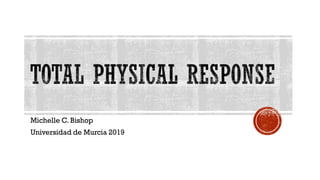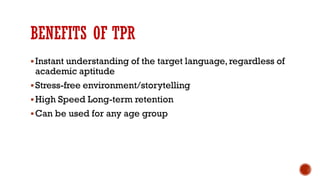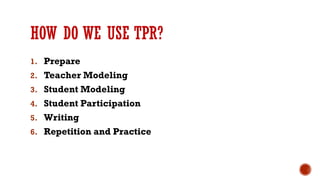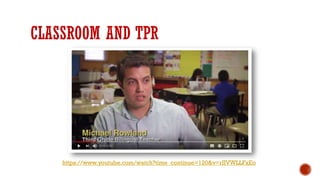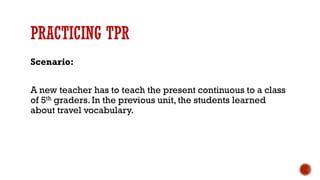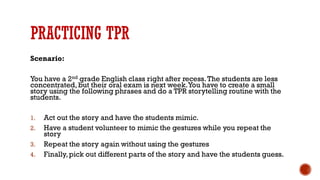English Seminar - Total Physical Response (TPR)
- 1. Michelle C. Bishop Universidad de Murcia 2019
- 2. WHAT ARE WE GOING TO LEARN? 1. What is TPR? 2. Benefits of TPR 3. How do we use TPR? 4. How can we incorporate TPR in the classroom? 5. Practicing TPR methods
- 3. WHAT IS TOTAL PHYSICAL RESPONSE?  Total Physical Response (TPR) is a method of teaching language or vocabulary concepts by using physical movement to react to verbal input.  The process mimics the way that infants learn their first language, and it reduces student inhibitions and lowers stress.The purpose of TPR is to create a brain link between speech and action to boost language and vocabulary learning.  It is an effective strategy to use with English Language Learners as well as with native speakers when learning new words.
- 4. WHAT IS TOTAL PHYSICAL RESPONSE? “The instructor is the director of a stage play in which the students are the actors”
- 5. BENEFITS OF TPR Instant understanding of the target language,regardless of academic aptitude Stress-free environment/storytelling High Speed Long-term retention Can be used for any age group
- 6. HOW DO WE USE TPR? 1. Prepare 2. Teacher Modeling 3. Student Modeling 4. Student Participation 5. Writing 6. Repetition and Practice
- 7. HOW DO WE USE TPR? What gestures would we use to express these statements?  You are asking for two of something  You are promising  You are telling the other person to stop talking  You are telling someone that they are crazy  You are asking for the bill in a restaurant  You are showing that you don’t like something  You are showing that you don’t know  You are telling someone not to be nosy/ to mind their own business  You are complaining about someone being late
- 8. HOW DO WE USE TPA? Put Get/ take Pick Turn Walk Throw Look Fall Lie Run Break Fill Grow Go Give Sit Ask Sort Move Come
- 10. PRACTICING TPR Scenario: A new teacher has to teach the present continuous to a class of 5th graders. In the previous unit, the students learned about travel vocabulary.
- 11. PRACTICING TPR Scenario: You have a 2nd grade English class right after recess.The students are less concentrated,but their oral exam is next week.You have to create a small story using the following phrases and do a TPR storytelling routine with the students. 1. Act out the story and have the students mimic. 2. Have a student volunteer to mimic the gestures while you repeat the story 3. Repeat the story again without using the gestures 4. Finally,pick out different parts of the story and have the students guess.
- 12. PRACTICING TPR Scenario: The students need to learn the following phrases: wash your hands your face your hair the cup look for a towel the soap eat an apple soup sandwich brush your teeth your hair the cat
